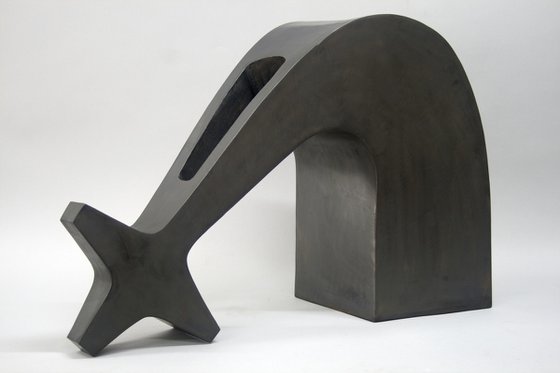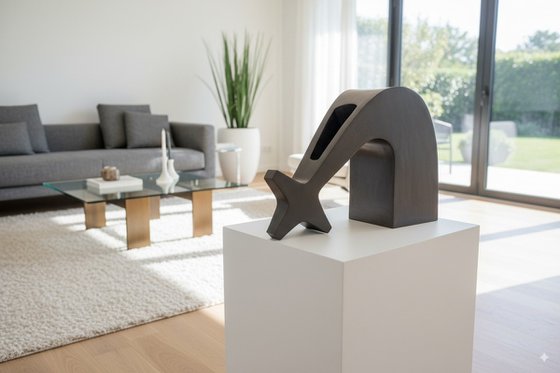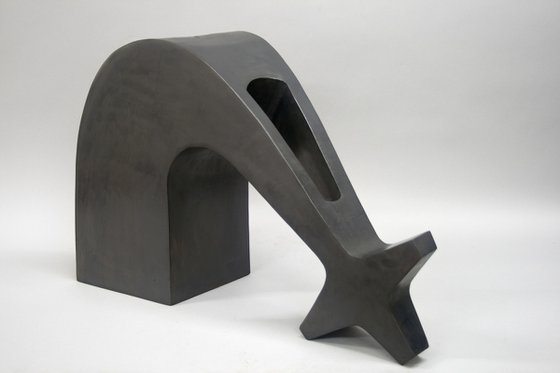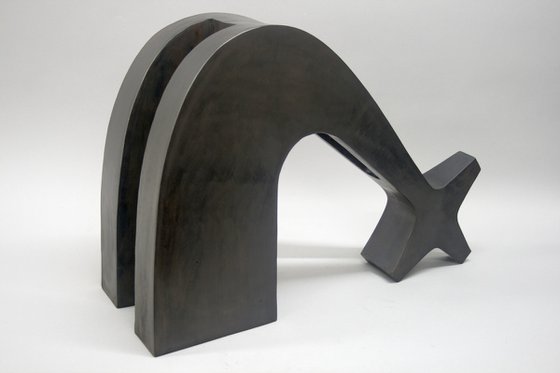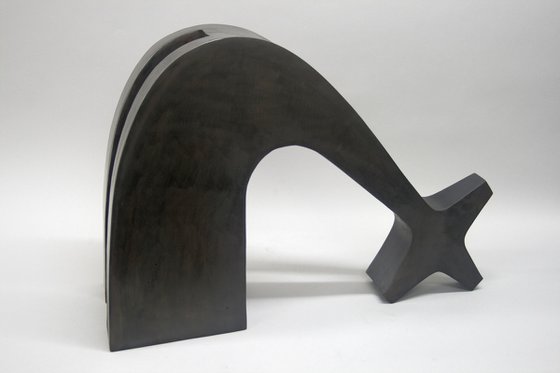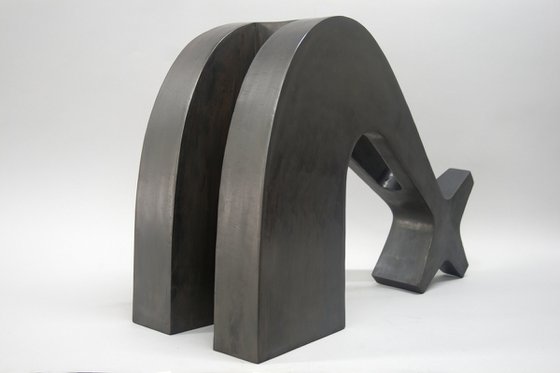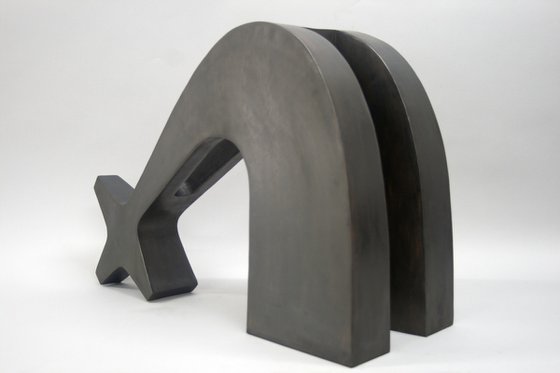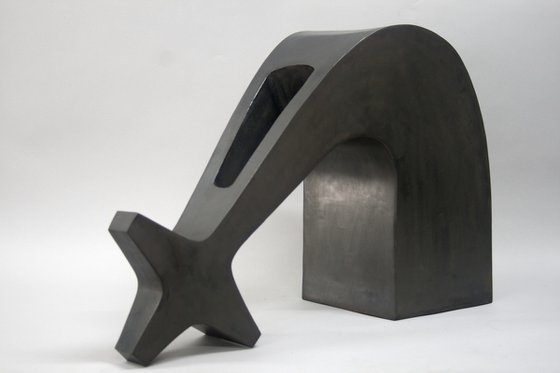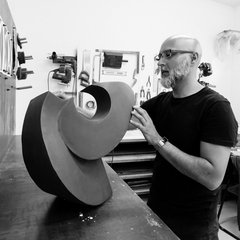Main Navigation
Artwork description:
La escultura Orante 2 es una abstracción de la figura humana en actitud de rezo, un gesto universal que atraviesa culturas, religiones y épocas. En ella, el cuerpo se reduce a un volumen esencial que sugiere recogimiento y elevación espiritual. La austeridad de las formas, desprovistas de ornamento, conduce al espectador a una lectura simbólica más que figurativa: no se trata de una persona concreta, sino de la humanidad en su dimensión trascendente.
El uso del acero, trabajado con contundencia y patinado en negro, otorga a la pieza una presencia rotunda que remite a la arquitectura brutalista de mediados del siglo XX. Al igual que aquella corriente, la obra apuesta por la sinceridad material, la geometría directa y la fuerza del volumen puro como medio de expresión. En este sentido, la obra dialoga con los principios de “verdad estructural” que defendieron arquitectos como Le Corbusier o Louis Kahn, trasladados aquí al terreno escultórico.
Orante 2 también se sitúa en la estela de escultores del siglo XX que exploraron la relación entre forma, materia y espiritualidad. La contundencia geométrica evoca a Eduardo Chillida y Jorge Oteiza, cuyas obras buscaban abrir espacios de meditación a partir de la masa y el vacío. La tensión entre peso y ligereza, propia del hierro y del acero, recuerda igualmente a la investigación de Richard Serra sobre la monumentalidad y la experiencia corporal frente al objeto.
Asimismo, la simplificación formal y la fragmentación de volúmenes guardan relación con el legado del cubismo escultórico de inicios del siglo XX, presente en artistas como Picasso, Archipenko o Jacques Lipchitz. Al igual que ellos, Orante 2 traduce la figura humana en un lenguaje geométrico esencial, en el que los planos y los volúmenes no buscan la mímesis, sino una relectura conceptual y simbólica del cuerpo.
De esta manera, la pieza se ofrece como un cruce de caminos entre la abstracción cubista, la contundencia del brutalismo arquitectónico y la espiritualidad latente en la escultura contemporánea. En su sobriedad se esconde una invitación a la contemplación: la conciencia de que, pese a las diferencias históricas y culturales, la acción de orar permanece como un símbolo universal de búsqueda interior y comunión espiritual.
The sculpture Orante 2 is an abstraction of the human figure in the act of prayer, a universal gesture that transcends cultures, religions, and epochs. Here, the body is reduced to an essential volume suggesting both spiritual elevation and inner recollection. The austerity of its form, stripped of ornament, invites the viewer to a symbolic rather than figurative reading: it is not a specific person, but humanity itself in its transcendent dimension.
The use of steel, worked with firmness and finished in a black patina, gives the piece a powerful presence that recalls the brutalist architecture of the mid-20th century. Like that movement, the work embraces material honesty, direct geometry, and the expressive force of pure volume. In this sense, it resonates with the principles of “structural truth” advocated by architects such as Le Corbusier and Louis Kahn, here translated into sculptural form.
Orante 2 also aligns with 20th-century sculptors who explored the relationship between form, matter, and spirituality. Its geometric force evokes Eduardo Chillida and Jorge Oteiza, whose works sought to open spaces of meditation through the interplay of mass and void. The tension between weight and lightness, inherent to iron and steel, also recalls Richard Serra’s investigation into monumentality and the bodily experience of sculpture.
At the same time, the formal simplification and the fragmentation of volumes connect the piece to the legacy of sculptural Cubism in the early 20th century, as seen in the work of Picasso, Archipenko, or Jacques Lipchitz. Like them, Orante 2 translates the human figure into an essential geometric language, where planes and volumes do not aim for mimesis but for a conceptual and symbolic re-reading of the body.
Thus, the work emerges as a crossroads between Cubist abstraction, the raw power of Brutalist architecture, and the spiritual undercurrent of contemporary sculpture. In its sobriety lies an invitation to contemplation: a reminder that, despite cultural and historical differences, the act of prayer endures as a universal symbol of inner search and transcendent communion.
Materials used:
Steel
Tags:
#sculpture #cubism #steel #architechture #iron abstract #cubism abstractionOrante 2 (2025) Sculpture
by Roberto Canduela Luengo
4 Artist Reviews
£1,732.6
- Sculpture on Other
- From a limited edition of 5
- Size: 55 x 38 x 24cm
- Ready to hang
- Signed and numbered certificate of authenticity
- Style: Geometric
- Subject: Abstract and non-figurative
Loading
Artwork description
La escultura Orante 2 es una abstracción de la figura humana en actitud de rezo, un gesto universal que atraviesa culturas, religiones y épocas. En ella, el cuerpo se reduce a un volumen esencial que sugiere recogimiento y elevación espiritual. La austeridad de las formas, desprovistas de ornamento, conduce al espectador a una lectura simbólica más que figurativa: no se trata de una persona concreta, sino de la humanidad en su dimensión trascendente.
El uso del acero, trabajado con contundencia y patinado en negro, otorga a la pieza una presencia rotunda que remite a la arquitectura brutalista de mediados del siglo XX. Al igual que aquella corriente, la obra apuesta por la sinceridad material, la geometría directa y la fuerza del volumen puro como medio de expresión. En este sentido, la obra dialoga con los principios de “verdad estructural” que defendieron arquitectos como Le Corbusier o Louis Kahn, trasladados aquí al terreno escultórico.
Orante 2 también se sitúa en la estela de escultores del siglo XX que exploraron la relación entre forma, materia y espiritualidad. La contundencia geométrica evoca a Eduardo Chillida y Jorge Oteiza, cuyas obras buscaban abrir espacios de meditación a partir de la masa y el vacío. La tensión entre peso y ligereza, propia del hierro y del acero, recuerda igualmente a la investigación de Richard Serra sobre la monumentalidad y la experiencia corporal frente al objeto.
Asimismo, la simplificación formal y la fragmentación de volúmenes guardan relación con el legado del cubismo escultórico de inicios del siglo XX, presente en artistas como Picasso, Archipenko o Jacques Lipchitz. Al igual que ellos, Orante 2 traduce la figura humana en un lenguaje geométrico esencial, en el que los planos y los volúmenes no buscan la mímesis, sino una relectura conceptual y simbólica del cuerpo.
De esta manera, la pieza se ofrece como un cruce de caminos entre la abstracción cubista, la contundencia del brutalismo arquitectónico y la espiritualidad latente en la escultura contemporánea. En su sobriedad se esconde una invitación a la contemplación: la conciencia de que, pese a las diferencias históricas y culturales, la acción de orar permanece como un símbolo universal de búsqueda interior y comunión espiritual.
The sculpture Orante 2 is an abstraction of the human figure in the act of prayer, a universal gesture that transcends cultures, religions, and epochs. Here, the body is reduced to an essential volume suggesting both spiritual elevation and inner recollection. The austerity of its form, stripped of ornament, invites the viewer to a symbolic rather than figurative reading: it is not a specific person, but humanity itself in its transcendent dimension.
The use of steel, worked with firmness and finished in a black patina, gives the piece a powerful presence that recalls the brutalist architecture of the mid-20th century. Like that movement, the work embraces material honesty, direct geometry, and the expressive force of pure volume. In this sense, it resonates with the principles of “structural truth” advocated by architects such as Le Corbusier and Louis Kahn, here translated into sculptural form.
Orante 2 also aligns with 20th-century sculptors who explored the relationship between form, matter, and spirituality. Its geometric force evokes Eduardo Chillida and Jorge Oteiza, whose works sought to open spaces of meditation through the interplay of mass and void. The tension between weight and lightness, inherent to iron and steel, also recalls Richard Serra’s investigation into monumentality and the bodily experience of sculpture.
At the same time, the formal simplification and the fragmentation of volumes connect the piece to the legacy of sculptural Cubism in the early 20th century, as seen in the work of Picasso, Archipenko, or Jacques Lipchitz. Like them, Orante 2 translates the human figure into an essential geometric language, where planes and volumes do not aim for mimesis but for a conceptual and symbolic re-reading of the body.
Thus, the work emerges as a crossroads between Cubist abstraction, the raw power of Brutalist architecture, and the spiritual undercurrent of contemporary sculpture. In its sobriety lies an invitation to contemplation: a reminder that, despite cultural and historical differences, the act of prayer endures as a universal symbol of inner search and transcendent communion.
Materials used:
Steel
Tags:
#sculpture #cubism #steel #architechture #iron abstract #cubism abstraction14 day money back guaranteeLearn more
